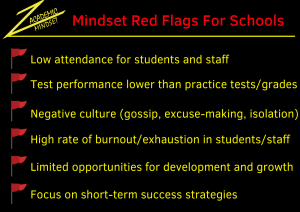The best leaders know that one of the biggest enemies to success is stagnation. If you are stuck and are not moving forward, it won’t be long before you backslide. Often, schools get frozen in place – never advancing or jumping to a new level. Mindset issues get a tight grip on these schools and hold them back from reaching their true potential.
As we partner with innovative school leaders around the country, we have found these 6 red flags to be the largest barriers to school success.

Removing these red flags can get your school “unstuck” and help your students and teachers to perform at their best with consistency. Along with signing up for our world-class mindset curriculum, here are tips and research-based guidance on how to reduce the 6 red flags for schools.
1: Low attendance for students and staff. School leaders spend a great deal of time and energy considering why students and teachers do not show up to school. As burnout rates increase in teachers and truancy rates rise for students, leaders around the country are baffled by the various reasons why attendance is low.
Try shifting the question. Instead of worrying about why attendance is low, start considering why people show up? What are the factors that lead to positive gains in attendance? Do teachers come to feel valued, to grow professionally, to transition into leadership roles, etc.? Are students looking for positive interactions, certain types of electives or club offerings, consistency in their routine? As you engage in conversations and gain understanding of the “why” for your staff and students, you will have your answer for increasing attendance. Bring your attendance up by fulfilling the why of your stakeholders and make sure to have conversations with your communities on how you intend to fulfill that why.
2: Test performance lower than practice tests/grades. The data seems to be on track. Student gains are consistent throughout practice testing. Finally, the big state test comes up and the gains suddenly disappear! It’s much more common than you might think.
Try removing the pep talks. It is easy to get caught up in the “big test talk.” We spout every motivational speech we can think of while inundating teacher with any test prep practice we can get our hands on. The intentions are good because we want to see success. The problem is that we create high-pressure situations without preparing our teachers or students to perform under high pressure. Create balance by making the big test “just another day.” It’s important, but it is not special. Keep the pressure on with high expectations throughout the year and maintain consistency, not adding or subtracting to that pressure as you get closer to testing.
3: Negative culture (gossip, excuse-making, isolation). “What you permit, you promote.” Negative culture often comes from indifference. Allowing your students or staff to fuel gossip, make excuses, or isolate themselves will become the norm very quickly. We cannot allow these mindset issues to destroy school culture.
How do we make an impact without becoming too strict or imposing? It starts with proactive behaviors. Make positive mindset a priority in every communication and action with teachers and students. Infuse your culture with mental toughness and resilience. Convert excuses to accountability statements. Culture shifts do not happen with rules and penalties. They happen with proactive measures, positive community-building, and a refusal for mediocrity.
4: High rate of burnout/exhaustion in students/staff. Burnout is a silent syndrome. It creeps in quietly and once it is at it’s worst, it is nearly impossible to overcome. Worse yet, research by Kim, Youngs, & Frank (2017) shows that burnout is contagious. As some members of your staff and students feel it, it transfers to others.
The best cure for burnout is preventative. Be aware and in constant communication with all stakeholders (including your administration team and yourself) about job roles and potential stressors. Shift responsibilities and priorities as needed to ensure every member of your staff is performing at their best. Also, place a constant importance on physical and emotional wellness. Employ exercise and physical movement along with mindfulness techniques. Provide information on mental health year-round. Beat burnout before it beats down your school!
5: Limited opportunities for development and growth. We hear the same complaint over and over again from students and teachers alike. “I just can’t grow here.” School leaders have a tremendous task of creating an environment of growth amidst a million factors that stand in the way of that growth. Budget issues, time restraints, and district pressure may interrupt your school’s development.
Ensure that there is a focus on leadership development in your school with an inclusive pipeline. Don’t run the risk of playing favorites among students or staff. Give everyone the opportunity for professional development and advancement. This can be run through clubs, organizations, or optional PD programs. Place an emphasis on growth and create resources to foster that growth regularly. How about a game-changing book study for your teachers?
6: Focus on short-term success strategies. Pressure is real and looming. Results are expected. Parents, communities, school districts, advocates, and many other groups are constantly watching the data and achievements of your schools. Under that pressure, it’s easy to see why many leaders invest in programs, curriculum, and opportunities to fuel short term success. We pour time, energy, and money into very specific test prep, new curriculum that functions the same as old curriculum, and training meant to give quick and short boosts to data.
Anything you decide to add to your school should have a long term potential impact. With each decision, consider the role and potential impact of what you are adding to your school. Bring programs that do not just update information, but simultaneously update methods and approaches to learning. Evaluate research and practice to bring the tools and resources necessary to bring the highest impact to your community for a long term. Invest in the SEL/mindset skills of your staff and students as those skills will help them on every test, in every class, and with every phase of their life! For example, investing in our mindset curriculum for students comes at a very low financial cost, but has shown to have a lasting and meaningful impact on students that carry over to every subject, test, and activity they participate in. It’s a no-brainer!
What are the red flags holding your school back? Be on the lookout for them and have a plan in place to overcome these barriers.
